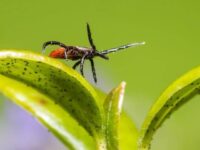This post contains affiliate links. If you click on a link and make a purchase I earn a commission at no extra cost for you.
Permethrin is an insecticide that is effective to kill and repel insects, mites, and ticks. Permethrin is used as an active ingredient in spot-on, powders, sprays, shampoos, emulsions, and solutions to combat lice, fleas, mites, and ticks. Permethrin is also used as a repellent to impregnate clothing or mosquito nets.
What is Permethrin?
Permethrin is a generic name of a synthetic chemical. Permethrin is an insecticide and acaricide, it belongs to the pyrethroids, a group of synthetic insecticides, based on the naturally occurring insecticide in Chrisantenum flowers (Tanacetum cinerariifolium).
Pure permethrin is present as a yellow to slightly orange-brown, lipophilic, viscous liquid or as a dried hard substance that is almost insoluble in water.
How does Permethrin Work
The insecticide permethrin works by paralyzing and killing insects and mites. The parasites get affected by eating or touching this chemical. It works as a neurotoxin as such spreads quickly throughout the insect body affecting the parasite’s muscles and nervous system. Here it causes sensory overexcitability through the uncontrolled release of neurotransmitters, coordination disorders, and exhaustion which results in cramps, paralysis. The insect is unable to move within a few minutes, one speaks of a “knock-down” effect. This ultimately leads to the death of the insect.
Acute toxicity to humans and most mammals is low when used as recommended. Absorption is low, permethrin is oxidatively broken down in the liver and quickly excreted.
Permethrin is highly toxic to aquatic life such as fish, amphibians, and reptiles. It must not get into the water
Products containing permethrin must never be used in cats. It is toxic to cats as they lack the enzyme necessary to break it down.
Mode of application of permethrin
There are different forms of application for permethrin. For pets, the most common are Spot on preparations or collars. Other formulations are lotions, cream, and pump sprays depending on their use.
Spot-on for dogs:
There are different spot-on medication of permethrin is available for dogs. A spot-on preparation, usually a liquid antiparasitic agent in an ampoule that is applied to the dog between the shoulder blades or in the neck area is convenient and easy to apply. The active ingredient spread through the whole coat via the dogs’ fat glands (sebaceous glands). Ticks and fleas die within 48 hours after contact with skin or fur, hopefully, before they suck blood. A single treatment usually lasts up four to eight weeks depending on the dose. Often products are a combination of permethrin and picaridin or other repellents.
Anti-tick collar:
Anti-parasite collars are convenient to protect pets against ticks, fleas, and mites. Its mode of application is very simple and easy. Simply put the collar around the neck of the animal. Compared to spot-on preparations, which usually have to be dripped onto the skin of the pet every few weeks, the collars keep their protective effect for weeks and months. After application, the active ingredients are continuously distributed via the natural fat film to the skin and coat.
Anti-tick sprays for clothing
There are also permethrin sprays available to treat clothing and create a protective shield that repels or kills parasites that get in contact with the garment. You may buy clothing that is already factory treated or buy the spray and treat the fabrics yourself. The application is very simple, make sure you follow instructions.
Fabrics treated with permethrin cause a “hot foot effect” in ticks or if exposure is high cause the tick to die, either way, they fall off before they find a suitable bite site. and as a result, they simply fall off.
These sprays also work for treating shoes, boots, waders, backpacks, tents, camp furniture, hammocks, mosquito netting, luggage, and bedsheets.
Rare side effects and dangers of permethrin use
As with everything: where there is a desired effect there can also be an undesired effect. Some rare side effects that are associated with permethrin use may include:
- Mild burning and stinging sensation
- Tingling at the site of application
- Numbness of skin
- Itching
- Redness of skin
- Skin rashes
- Swelling of skin
People in today’s world seem to become more and more allergic to all sorts of stuff, from peanuts to strawberries, to prawns, everything is possible. So no wonder that there can also be some very serious allergic reaction permethrin.
If you are allergic to it, you must avoid its use. If you notice any symptoms of a an allergic reaction seek immediate medical attention. The symptoms of an allergic reaction to permethrin include but are not limited to:
- Rash
- Itching
- Swelling of the face, tongue, and throat
- Severe dizziness
- Trouble breathing
Advantages
There are a number of advantages associated with permethrin. Some of these are given below.
- Highly effective
- Repels and kills parasites such as ticks, mites, fleas, and lice, mosquitos, etc.
- Provides long-lasting protection
- Suitable for treatment of acute infestations
- Different formulations and mode of application available
Disadvantages
The disadvantages associated with permethrin include:
- Toxic to all insects, kill beneficial organisms too, such as bees
- May cause allergic reactions
- Very toxic to cats
- Highly toxic to aquatic organisms
Conclusion is permethrin safe
Protection against parasites is critical to prevent diseases. Tick-borne and mosquito-borne diseases are some of the greatest plaques and kill millions of people every year. Animals and pets are just as affected.
Permethrin is used as a contact and feeding poison against ticks and fleas in dogs and has proven itself millions of times over in the last few decades as a well-tolerated and reliably preparation that fleas and ticks at a distance or ensures that they are quickly killed.
Permethrin is ideal also for treating mosquito nets and clothing. Harmful effects on humans and undesirable side effects have so far hardly been known and can be neglected compared to the benefit of using insect repellents.
For additional protection against ticks and blood-sucking insects that can transmit diseases, personal insect repellents are recommended.
Source and more to read:
National Pesticide Information Center
Health Effects of Permethrin-Impregnated Army Battle-Dress Uniforms



